|
Published monthly for CC employees by Clinical
Center Communications
June 1999
Diabetes
cure
Looking back
Great words sought
Letters
Nursing's awards
Patient education
Brick-a-brac
News briefs
|
|
|
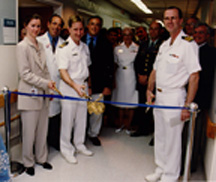 |
|
Cutting the ribbon to open the new Organ and Tissue Transplant
Research Center are (left to right) Terri Wakefield, R.N., M.S.,
the unit's head nurse; Cmdr. Allan Kirk, US Navy, and Capt. David
Harlan, US Navy, the two researchers heading clinical trials
of novel antirejection therapies to be given after transplants
of islet cells and kidneys. |
Transplant studies at CC could lead to diabetes cure
Close to 100 people gathered last month to celebrate the opening
of the new Organ and Tissue Transplant Research Center in the
freshly remodeled 11-East patient care unit.
In opening remarks, Dr. Allen Spiegel, director of intramural
research for NIDDK, called the new unit "a venue to test
the newest, most innovative ways of overcoming transplant rejection
for patients with type 1 diabetes and end-stage renal failure,
and ultimately other diseases."
Patients on this new unit will receive transplants of either
insulin-producing islet cells or kidneys, followed by novel therapies
to prevent their immune systems from rejecting the transplants.
If the therapies are successful, these patients could be cured
of their diabetes or renal disease.
Rejection is a major hazard of organ or tissue transplantation.
Powerful drugs are given to suppress the patient's immune response,
but side effects can be unpleasant enough to cause patients to
stop taking the drugs. This step can mean almost certain organ
rejection.
"Very rarely a patient that stops taking antirejection
medicine does not reject the transplanted organ," said Dr.
David Harlan, head of the new unit. "So we do know that
it's possible to achieve a state of peaceful coexistence between
the transplanted organ and the recipient's immune system."
Recent research in rhesus monkeys has lead to immunologic
strategies using antibodies to block the rejection process and
essentially fool the body into thinking that the transplanted
tissue is its own.
This research has been spearheaded by Dr. Harlan and Dr. Allan
Kirk, of the Naval Medical Research Center. In partnership with
the Clinical Center, NIDDK, Walter Reed Army Medical Center,
and the University of Miami's Diabetes Research Institute, Drs.
Harlan and Kirk plan to test their promising therapy, and others,
in patients here at the Clinical Center.
"With these new therapies, we are trying to manipulate
the immune system so that this peaceful coexistence happens more
often," said Dr. Harlan.
At the ribbon cutting, Dr. Kirk explained the team's vision
for the new unit: "The common goal is to cure people with
diabetes and renal failure -- and every other end-stage organ
disease that is amenable to transplantation -- and to do so without
giving the patient another disease, that is, immunosuppression.
I truly believe that we are extraordinarily close to being able
to do that."
"This is among the most exciting scientific opportunities
I've seen for the Clinical Center in the last 10 years,"
said Dr. David Henderson, deputy director for clinical care.
"It's what this building was built for-to translate these
wonderful basic science findings [in animals] to humans."
Each of the other collaborating entities brings special resources
to the enterprise:
- The Clinical Center will provide the operating rooms, the
patient care facilities, a nursing staff headed by Terri Wakefield,
R.N., M.S., and the myriad services needed to support clinical
research.
- The University of Miami team are the experts in islet cell
isolation and purification. They will assist the CC's Department
of Transfusion Medicine in setting up islet cell production in
DTM's cell processing section.
- Walter Reed staff bring a 30-year history of clinical transplant
experience.
- And NIDDK honors its commitment to diabetes research by generously
funding the enterprise.
Dr. Henderson lead the team that brought the 11-East unit
renovation and other preparations to a remarkably speedy completion.
"The uniqueness of the Clinical Center gives us the organizational
flexibility to create something like this practically overnight,"
he said. "This was only a concept in someone's mind just
late last summer."
Once the decision to move forward was made, work proceeded
quickly. A prerequisite was to become certified as a transplant
center by the United Network for Organ Sharing (UNOS), an organization
that ensures compliance with all the rules that are associated
with transplanting human organs and tissues.
"We started in the fall [of 1998] trying to get [UNOS]
certification; we had to renovate a unit; we had to assemble
a transplant team; we had to figure out what resources were necessary
to support it-across our whole organization. Plus we had to find
people who have that expertise and get them hired. And literally
from the time we started-in late August or early September-until
now, it's all done," said Dr. Henderson.
A nucleus of stakeholders met every Wednesday. "The group
worked unbelievably well together," Dr. Henderson explained.
"Everyone participated, paid attention, recognized when
we'd hit a minor obstacle, and people had creative ideas about
how to solve it."
Dr. Henderson also credits the staff of the Division of Engineering
Services for their diligence in seeing that the unit renovation
proceeded smoothly and at a record-setting pace. A process that
normally takes 18 months was collapsed into 4 to 6 months, he
said. "Scott Robinson and Dyal Sharma headed the effort.
They delivered the project on time, and under budget," Dr.
Henderson said.
At the ribbon cutting, Dr. Harlan summed up: "While it
is well and good that we celebrate the wonderful achievement
that this ward represents - and we should savor this moment -
we must then quickly roll up our sleeves and get back to the
work designed to relieve the suffering of those we have pledged
to serve. That's why the NIH is here. We really can't rest until
we've achieved that mission."
 |
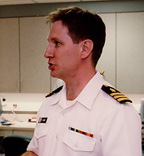 |
|
Dr. David Harlan |
Dr. Allan Kirk |
Hear Harlan and Kirk live
Dr. David Harlan, Dr. Allan Kirk, and their colleague Dr.
Norma Kenyon are the panelists on the next Clinical Center RoundTable,
June 18. The program on organ transplantation broadcasts to medical
schools and hospitals nationwide. You can watch it live in Lipsett
Amphitheater at noon. |
index |
|
|
Looking back; looking ahead
CC Director John Gallin at the 5-year mark
Dr. John I. Gallin marked his 5th anniversary as director
of the Clinical Center on May 1. He discussed with CCNews what
the next 5 years may bring. Part II of II.
--
CCNews: Obviously the new hospital construction
will be a major development over the next few years. Other than
that, what do you see as most significant for the next 5 years
of the CC's history? Or would that be it?
John Gallin: No, the next 5 years will be the real hard
work to sustain the initial efforts to improve efficiency for
all Clinical Center components. All the patients who come here
are on protocols, providing us a unique opportunity among hospitals
to plan with some precision, and to monitor how well our plans
are being implemented.
And to do that we are putting a lot of effort into protocol
mapping, where every day of a patient's visit, whether outpatient
or inpatient, will be planned in advance with as much detail
as can possibly be put into it. We are in the process now of
having the initial hand-developed protocol maps turned into computer-developed
maps. And the computer-developed maps will make it easier not
only to write them, but to link the protocol-mapping process
to a new activity-based costing system, which we are putting
in to modernize our ability to track costs and to plan better.
The planning of the budget of the Clinical Center should be linkable
to the maps, if it's done right.
The maps will also be linked to a new Clinical Research Information
System, or CRIS, that will replace the Medical Information System,
or MIS. Our goal is automatic scheduling of appointments and
activities in the hospital.
Computerized protocol maps should also facilitate our communication
with our referring physicians by having prescheduled, investigator-written
draft letters automatically forwarded to our physicians for editing
prior to mailing.
So developing a new hospital clinical research information
system, which is a very major, expensive effort, probably costing
$30 -- $40 million dollars or more; the development of protocol
mapping; the development of an activity-based costing system;
and then implementing all of this and making it easy and fun
and seamless for the person who is using it, will be major events.
Other changes in the informatics program will occur in the
next 5 years. We won an award this year as one of the 100 "most
wired hospitals" in America. Steve Rosenfeld has the plaque.
We're "wired" because we have a good informatics program,
but it's really not where I want it to be. I want all the many
images that we generate -x-rays, retinal exams, biopsies, etc.
- and all of our data to be freely accessible to our care providers.
All patient data, which will be encrypted to assure patient confidentiality,
should be accessible on the screen and then archived into a data-vault.
All the data should be easily analyzed for research purposes.
This will be a complex but important component of the new Clinical
Research Center.
Telemedicine is an important technology we are developing.
Telemedicine provides a way to facilitate recruitment of patients,
facilitate collaborative research efforts between the NIH and
the outside world ­ the extramural community ­ and facilitate
follow-up of patients after they've been here. We've already
started building telemedicine clinics here.
We also need to develop further training in clinical research
and define what are the necessary elements to do clinical research.
The Medical Executive Committee recently had a retreat to develop
standards of clinical research. The standards will have two elements:
those for the infrastructure and those for the principal investigator.
Should clinical investigators be credentialed? What standards
are needed to establish uniformly the highest quality clinical
research across the country?
In terms of accomplishments, the recruitment of patients is
certainly a major sensitivity that we didn't have to worry about
20 years ago, but times have changed. The establishment of the
Patient Recruitment and Public Liaison Office is, I think, a
substantial statement in terms of what is happening to patient
recruitment nationally, the impact of managed care on patient
recruitment, and the fact that fewer and fewer patients have
an identifiable doctor. Patients have managed-care organizations
taking care of them; they don't have an individual they can say,
"This is my doctor." And that makes it harder for them
to find places like NIH in one sense. In another sense, with
the development of the internet and all its power, patients are
now reading about the NIH and learning what we have to offer.
The Medical Executive Committee has changed policies here to
let patients self refer or the family refer, and that is a significant
change from the old policy of physician referral only.
The Clinical Center is constantly improving the consult services
to improve patient care. This year we started the new Medical
Consult Service and recruited Dr. Fred Gill to run a new internal
medicine consult service.
As an institution, we are redefining where we're going in
terms of research. For example, the opening of the new NIDDK-sponsored
organ transplant unit last month [see story on page 1] is a very
important statement that there's a whole new area to pursue.
Once the Genome Project is completed in just a few years, the
post-genome era will start, and we can adapt to that. There are
all sorts of new opportunities for understanding existing diseases
and identifying new diseases, and relating the discovery of a
gene to a physiologic process and then to a medication for the
disease. The Genome Project is going to open new opportunities
and give birth to a new generation of investigators to study
the physiology of disease. The new Clinical Research Center will
provide a new house for these research programs.
CCN: Only 3 of the 9 CC directors have held the
post longer than you have, with Dr. Jack Masur leading with a
total of 16 years. What does the future hold for you?
JG: Nobody knows! I would like to stay here as long
as I can see things to do and feel excited about them. When the
day comes that I have to worry each day about what to do next
instead of things just flowing, then I think it's time to move
on.
I won't say that a person should only stay in a job for a
certain number of years, because I think it's very variable with
different individuals for how long that should be. I like it
here. I've been here for what's amounting to a substantial amount
of time, although I still don't think it's a long time. I could
see staying here certainly through moving into the new hospital,
which is its own challenge, and then I'd love to see some of
the things we've started really solidified and become a way of
life.
CCN: You have all the background knowledge of all
of these projects to lead the way. It would be difficult, I would
think, for someone to step in at this point and try to accomplish
things that are on the plate for the future.
JG: Well, I would never be so bold to say there's not
someone else who could come in and do it; I am sure there is.
But there is a certain advantage to continuity at this point,
I think. Just the process of concluding the building - it would
be a challenge for someone else to come in and catch up and be
up to speed at this point in time. But if I get killed by a bus
tomorrow, someone else will step in and, I am sure, do an outstanding
job.
CCN: What would you like to say to CC staff about
the Clinical Center as we near the start of the new millennium
and the beginning of the new hospital construction?
JG: I would say the Clinical Center staff has made
this place something very special. It's recognized as being special,
and the future only looks a lot more exciting than the past -
as exciting as the past has been.
I hope people are excited about the new hospital and all the
opportunities that it provides, and remember that the bottom
line in all this is to improve the health and well-being of all
the people in the country - who ultimately pay for us to do our
work.
I see the CC as a monument to our country's marvelous clinical
research effort. It's important for the workers here to treasure
the fact that they are working in such a special place, which
is special because they, and our patient volunteers, are here.
CCN: Thank you for your time.
JG: Thank you.
index |
|
Great words sought
Preliminary plans for the design of the Science Court in the
new Mark O. Hatfield Clinical Research Center have been approved.
The Science Court will be a square-90 feet on each side, and
seven stories high-with a magnificent double helix staircase
rising the full height of the building. Each landing of the staircase
will have notable quotations engraved in stone.
We are seeking 10 great quotations to be etched into the floors
on the helical stairway landings. A small committee will work
with Dr. Varmus to make the final selections. Guidelines for
the quotes are as follows:
- Quotations should be powerful words of wisdom, inspiration,
hope, insight, or beauty.
- Quotations should directly or indirectly relate to the mission
of the NIH and Clinical Center.
- Authors of the quotes should be deceased.
- All entries should be properly attributed, including author
and year. A source for the quotation should be cited.
- Quotations should be no greater than 100 words in length.
Please think about the words that most inspire you, and send
your candidate quotes via e-mail to Celia A. Hooper (Chooper@nih.gov).
Include your contact information, a correct citation of the quote,
the date of the quotation, and reference information so its accuracy
can be verified. Quotations will be accepted through June 30.
index
|
|
Letters
When I was admitted in mid-September 1997, I could never quite
have guessed I would be here at NIH as an inpatient for 1 year
and 8 months in a stretch. I am the girl that has been wheeling,
and lately walking, around with a black wheelchair, and my left
leg in a big bandage. I have counted my blessings for every new
day I have been here, because NIH has been able to help me.
During my stay I have had many experiences, all of them nice
ones. There has been everything from the groundbreaking ceremony
in Nov. 1997 to the astronauts' visit in Jan. 1999, and every
event in-between (holidays or not). I am truly grateful to everyone
I have had contact with here at NIH. I cannot possibly thank
you all individually, but I hope you know who you are: all "my"
nurses on 11-West, monthly fellows and residents, health care
technicians, physical and occupational therapy, social services
("my" social worker, voucher and cashier's office),
the clinics (especially Dentistry, Eye, Dermatology, Surgery,
ICUs, Special Procedures), Photography, the Nutrition Department,
Housekeeping, Escort, the elevator operators, volunteers, Pharmacy,
Ober Travel, everyone in the B-1 cafeteria, and the shops on
B-1. Also Spiritual Ministry, Recreational Therapy, the Day Hospital,
and everyone behind the scenes who have helped.
And oh! The doctors! Thank you most of all to Dr. Steven Holland
and Dr. John Gallin for not giving up on my case and me! You
all do a superb job-I hope you realize that. You have cared for
my health and my heart.
To all my fellow patients (mainly on 11-West), you know who
you are: Don't ever give up, and you are in my prayers. Someone
is praying for you, so you pray for someone else.
From the bottom of my heart,
Thank You.
Madeleine Wahlstrom
May 1999
index |
|
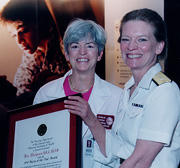 |
|
Nurse of the Year Ann Mulqueen (left) with CC Associate Director
for Nursing
Dr. Kathryn Lothschuetz Montgomery. |
Nursing's awards honor achievements
The Clinical Center Nursing Department honored its own May
6 at its Annual Meeting and Awards Ceremony, held in Lipsett
Amphitheater.
Nurse of the Year honors went to Ann Mulqueen, of 3-East,
and Distinguished Nurse honors went to Sharon Quint-Kasner of
the Clinical Informatics Service.
The Nursing Research Award went to Eunice Johnson, Debbie
Byrd, Elaine Robinovitz, Jackie Wootten, Linda McCullagh, Frank
Pucino, Tannia Cartledge, Robert Wesley, Domenica Rubino, Rene
Kimzey, Kulvinder Katie Singh.
Director's Award honors went to Robin Blauser; and the 1998
Nursing Department Shared Governance Steering Committee: Karen
Baker, Robin Blauser, Jacques Bolle, Priscilla Buck, Claudia
Briguglio, Allyson Browne, Laura Chisholm, Barbara Corey, Tammy
Jenkins, Nancy Stefan, Suzanne Sheets, Suzanne Spisso, and Dell
Wright.
The following people were awarded Citations for Excellence
in these areas:
- Teamwork: The Endocrine Program of Care Nursing Staff; The
2J & 10D Nursing Staff; and the 12 East/West/Experimental
Transplant Immunology Unit Nursing Staff.
- Administrative/research support: Bertram Brown, Alicia Garrison,
and Sharon McDowney.
- Research implementation: Alberta Aikin and Judy Zuckerman
- Nursing/Patient Education: Cathy Parker, and Rachelle Ramirez
- Patient Care: Gloria Ayukawa, Hilda Cardona, Nam-Yong Kim,
Delores Medina, Maria Zayas, and Su Yang; Madeline Gupta
- Leadership: Felicia Andrews, Pam Koviack, and Vicki Liberty
Nursing Executive Recognition Awards were given to Jeanne
Radcliffe, Nancy Stefan, Terri Wakefield, Diane Walsh, and Jan
Yates.
The following PHS Honor Awards were also given:
The Achievement Medal went to Lisa Barnhart, Reginald Claypool,
Rosemary McConnell, Mary Tolbert, Diane Walsh
PHS Citations went to: Felicia Andrews, Patricia Garzone,
Janet Jones, Akua Kwatemaa, Philantha Montgomery, Jeanne Odom,
Karen Vorsteg
Commendation Medals were awarded to: Laura Chisholm, Maria
Dinger, Irene Dustin, Lenora Jones, Ann Knebel, Kathy Matrakas,
Katherine McGilly, Marsha Moore
Unit Citations were awarded to the Clinical Standardization
Committee: Jeanne Odom; the 2E Steering Committee: Barbara Fuller;
and the Critical Care Program of Care: Diane Miskinis, Akua Kwatemaa,
Reginald Claypool, Peter Meccariello.
index |
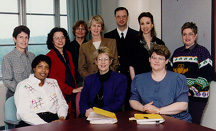 |
|
The Patient Education Task Force works to assure excellence in
patient education tools used at the Clinical Center. Standing
(left to right) are Nancy Sebring, Carol Romano (chair), Barbara
Corey, Louise Faehner, James Syms, Wendy Schubert, and Bonnie
Thornton. Seated (left to right) are Deborah Dozier-Hall, Amy
Collins, and Sharon Quint-Kasner. |
Patient education task force launches far-reaching initiatives
Interdisciplinary collaboration.
These are the watchwords for the CC's evolving approach to patient
education. While CC health professionals have always worked together
to perform this important task, a systematic strategy across
all departments did not exist. In response to JCAHO standards,
which stress interdisciplinary delivery of patient education
services, the patient education task force was formed in March
1998.
Chaired by Carol Romano, RN, Ph.D., FAAN, chief of the Nursing
Department's Clinical Informatics Services, the task force is
a subgroup of the CC Quality Assurance Committee. Comprising
16 CC staffers and consultants representing 14 departments, its
mission is 4-fold:
- to delineate existing CC patient education resources
- to develop a quality assurance process for these resources
- to maximize electronic media to support patient education
and the quality assurance process
- and to establish an interdisciplinary mechanism to document
patient education.
To date, the task force has made great strides in completing
its mission. The assessment of patient education materials revealed
that CC staffers use more than 3,000 tools to educate their patients.
To catalogue and access these tools, task force members are working
with ISD to design a web-based database. They also devised a
house-wide mechanism to develop and review materials created
by CC staff. This mechanism will enable individual departments
to assure that patient education tools meet agreed-upon criteria
for consistency and presentation.
Dovetailing with this effort is the documentation initiative,
in which members strive to develop MIS screens that accurately
show the patient education process as it occurs in patient care.
Ultimately, they aim to create a single interdisciplinary document
that reflects, in one place, the patient education documented
and delivered by all a patient's care providers.
Meeting the disparate needs of the disciplines involved has
been a formidable challenge for task force members. But with
perseverance and cooperation, members have found that, with regard
to patient education, the similarities between their professions
are greater than their differences. All are committed to providing
the best in patient care, and delivering quality patient education
is the overriding concern.
As the task force progresses towards its goal of assuring
excellence in patient education at the CC, Dr. Romano is confident
that this effort will have positive, long-range effects on the
continuing mission of the Clinical Center. "The task force
members consistently demonstrate their commitment to improving
the quality of care provided to our patients. It is a privilege
to work with such hard-working, dedicated professionals."
- by Wendy L. Schubert, Sc.M.
index |
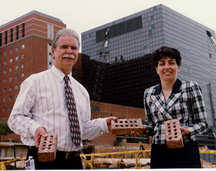
Brick-a-brac
In response to requests for souvenir bricks from the demolition
of part of the Clinical Center to make room for the new Mark
O. Hatfield Clinical Research Center, McCarthy Construction has
donated a pile of bricks to the Friends of the Clinical Center.
Sentimental CC'ers can consider a donation to FOCC and receive
a brick for posterity. Quantities are limited. Here, Al Rexroad
and Maria Stagnitto, FOCC president, wrangle over who gets this
especially fine specimen.
index |
|
News briefs
Survivors celebrate
If you have ever had cancer, or are a family member of a person
with cancer, come to the 13-East Outpatient Oncology Center for
National Cancer Survivors Day, June 8 ­ 11, from 11 a.m.
to 2 p.m., Bldg. 10, Room 13N214. Join the staff and others for
refreshments, reminiscing, and fun.
Timekeeping change
ITAS, the new timekeeping system already being used in many
NIH offices, is being rolled out at the Clinical Center. ITAS
stands for "Integrated Time and Attendance System."
To learn what you need to know about it, come to the next training
session, June 29, from 1 p.m. to 3 p.m. in Masur Auditorium.
Volunteers needed
Male volunteers over 40 years of age are needed for a study
to assess the effects of donating blood on prevention of heart
disease. Participants should have donated blood no more than
one time in each of the last 5 years, and given less than 15
units in their lifetime. Blood studies and a carotid ultrasound
will be done. Two outpatient visits are required. There is no
financial compensation for participants. For more information,
call Xin Fu at 2-4482.
TSP open season
Open season for the Thrift Savings Plan is May 15 through
July 31. FERS employees hired before Jan. 1, 1999, as well as
CSRS employees, may change their current election, or make an
initial participation election. Contact OHRM at 6-6924 for details.
index |
Editor: Sue Kendall
Clinical Center News, 6100 Executive Blvd.,
Suite 3C01, MSC 7511, National Institutes of Health, Bethesda,
MD 20892-7511. Tel: 301-496-2563. Fax: 301-402-2984. Published
monthly for CC employees by the Office of Clinical Center Communications,
Colleen Henrichsen, chief. News, article ideas, calendar events,
letters, and photographs are welcome. Deadline for submissions
is the second Monday of each month.
top | cc
home page | nih home
page | |
|

